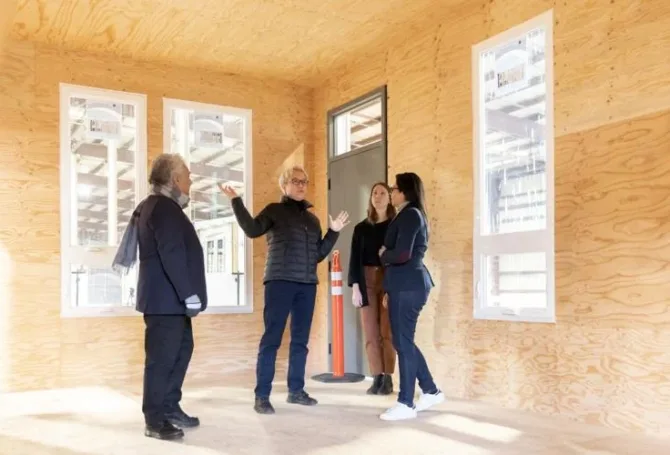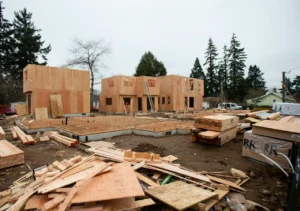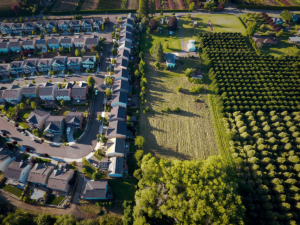
Changes Involve Land Use, Building Codes, Worker Training and Finance
Building 36,000 housing units per year in Oregon, double current production levels, will require a lot more money and a lot fewer regulations, according to the governor’s advisory council. Oregon hasn’t built 36,000 housing unit per year in five decades, which economists say has contributed to a lack of affordable housing, higher rents and increased homelessness.
 Governor Kotek’s Housing Production Advisory Council (HPAC) unveiled last week a 20-page summary of solutions to meet Kotek’s housing goal. The solutions include a smorgasbord of tax increases, each of which would generate more than $500 million before sunsetting by 2023.
Governor Kotek’s Housing Production Advisory Council (HPAC) unveiled last week a 20-page summary of solutions to meet Kotek’s housing goal. The solutions include a smorgasbord of tax increases, each of which would generate more than $500 million before sunsetting by 2023.
Kotek meets with council members this week to review the recommendations, but already has signaled she won’t submit any of the suggested tax increases to the 2024 legislature, which convenes February 5.
Meanwhile, Portland City Council is considering a list of 15 suggestions from the city planning commission to incentivize urban housing construction. The list, which includes reducing parking requirements for apartments and allowing housing developers to break ground before consulting with neighbors, met with divided opinions by council and community members.
Both sets of recommendations underline the challenges of providing needed infrastructure for housing in undeveloped areas, training more construction workers and balancing the need for housing with livability in existing neighborhoods. They underscore building 36,000 new housing units will take more than a magic wand.
Building 36,000 new housing units per year in Oregon
will take more than a magic wand.
HPAC Recommendations
The wide-ranging recommendations break down into five groups – land availability, land development, building and design codes, financing and workforce shortages.
 The council recommended leveraging publicly owned and leased land, including wetlands and brownfields, to produce housing under an emergency order issued by the governor. Recommendations also urged identifying funding streams to help cities build needed infrastructure and expediting urban growth boundary expansion.
The council recommended leveraging publicly owned and leased land, including wetlands and brownfields, to produce housing under an emergency order issued by the governor. Recommendations also urged identifying funding streams to help cities build needed infrastructure and expediting urban growth boundary expansion.
Development plan reviews and site inspections should be streamlined, the council recommended. Cottage clusters with five or fewer units wouldn’t need a courtyard, local jurisdictions must allow land-use standard adjustments for lot sizes, parking and ground floor uses for multiple-family housing.
ODOT should receive an additional $20 million annually for roadway improvements to serve new housing development. Land-use appeals for housing projects would be expedited and timelines would be shortened for annexations and comprehensive plan changes. Tree codes could be modified. Prevailing wage rates could be exempted for affordable housing.
Under financing, the council recommended creating a state revolving infrastructure loan fund that finances critical local infrastructure through potentially forgivable loans to pay for public facilities that support housing development. The council also recommended system development charge offsets, a middle-income housing fund and an insurance and risk pool.
 To address workforce shortages, the council recommended increasing apprentice numbers and investing $77 million over five years to generate 6,000 newly trained construction workers to fill the severe gap needed to produce 36,000 housing units annually. A housing production boot camp should be started to accelerate construction worker training. There also should be greater coordination between housing production and workforce needs, including for students at Oregon’s 17 community colleges.
To address workforce shortages, the council recommended increasing apprentice numbers and investing $77 million over five years to generate 6,000 newly trained construction workers to fill the severe gap needed to produce 36,000 housing units annually. A housing production boot camp should be started to accelerate construction worker training. There also should be greater coordination between housing production and workforce needs, including for students at Oregon’s 17 community colleges.
HPAC Funding Recommendations
The recommendations call for an independent Housing Finance Agency appointed by the governor to oversee and manage all state programs relating to real estate finance, including single-family mortgages and multi-family housing rental units.
Revenue-raising proposals included:
- Increasing all personal income tax brackets by 0.5 percentage points to raise $699 million.
- Establishing a $1 per $1,000 real property tax assessment above Measure 5′s voter-enacted limits to raise $504 million.
- Creating a 0.5% retail sales tax to raise $501 million.
- Establishing a 0.5% payroll tax to raise $620 million.
- Doubling the state’s fuel tax to raise $686 million.
Political conservatives jumped on the financing proposals, claiming Kotek was on the brink of proposing $3 billion in new taxes. Elisabeth Shepard, a spokeswoman for Kotek, said the governor asked the council to think big in light of her aggressive housing goal, but said the panel doesn’t speak for the governor. Shepard noted Kotek recently urged Portland officials to swear off tax increases for three years.
Kotek admits it will take time and resources to reach her aspirational housing goal. “I set this target to reflect the level of need that exists, knowing that we will not get there overnight,” Kotek said when first announcing her goal.
Portland Planning Commission Recommendations
The planning commission’s list of recommendations are aimed at reducing the cost to build new residential structures in Portland and meet the city’s goal of producing 120,000 new housing units by 2045.
 City commissioners expressed conflicting views of the proposed changes at a public briefing last week. Commissioner Carmen Rubio called the proposals a “very meaningful step forward”. Commissioner Rene Gonzalez came to the briefing with additional suggestions that included scrapping the city’s existing eco-roof and bird-safe window requirements.
City commissioners expressed conflicting views of the proposed changes at a public briefing last week. Commissioner Carmen Rubio called the proposals a “very meaningful step forward”. Commissioner Rene Gonzalez came to the briefing with additional suggestions that included scrapping the city’s existing eco-roof and bird-safe window requirements.
Developers said the recommendations were good but don’t go far enough to lower costs for urban housing production. A real estate representative said bird-safe windows would add $700 per year to apartment rental rates.
Environmental advocates took issue with Gonzalez’ proposals. “Green roof mandates and bird-safe building requirements are important environmental programs for the city, both won through extended public processes when they were adopted,” said Olyssa Starry, an urban ecology professor at Portland State University. “Our community is really tired of politicians who try to use the housing crisis as a pretext to roll back environmental and housing regulations.”
Rubio and Gonzalez are both announced candidates to replace Ted Wheeler as mayor in this year’s election.
Developers Weigh In
Representatives of the housing industry told legislators last year it will take money and flexibility to approach the governor’s annual housing production target.
Ernesto Fonseca, chief executive for the nonprofit Hacienda CDC, urged streamlining planning, permitting and financing processes to support more rapid housing development, including for modular homes that can be mass-produced.
 Andie Smith, vice president of Multifamily NW board of directors, said the apartment industry hopes Oregon will relax regulations for housing providers to drive down the cost of land, including making it easier to expand urban growth boundaries.
Andie Smith, vice president of Multifamily NW board of directors, said the apartment industry hopes Oregon will relax regulations for housing providers to drive down the cost of land, including making it easier to expand urban growth boundaries.
Deborah Flagan, vice president for Hayden Homes in Redmond, touted a model it has used to build housing for homeless veterans in only 18 months. The landowner had already installed utilities and Redmond designated a staff member to expedite permits and inspections. The project proceeded without public comment or appeals.




